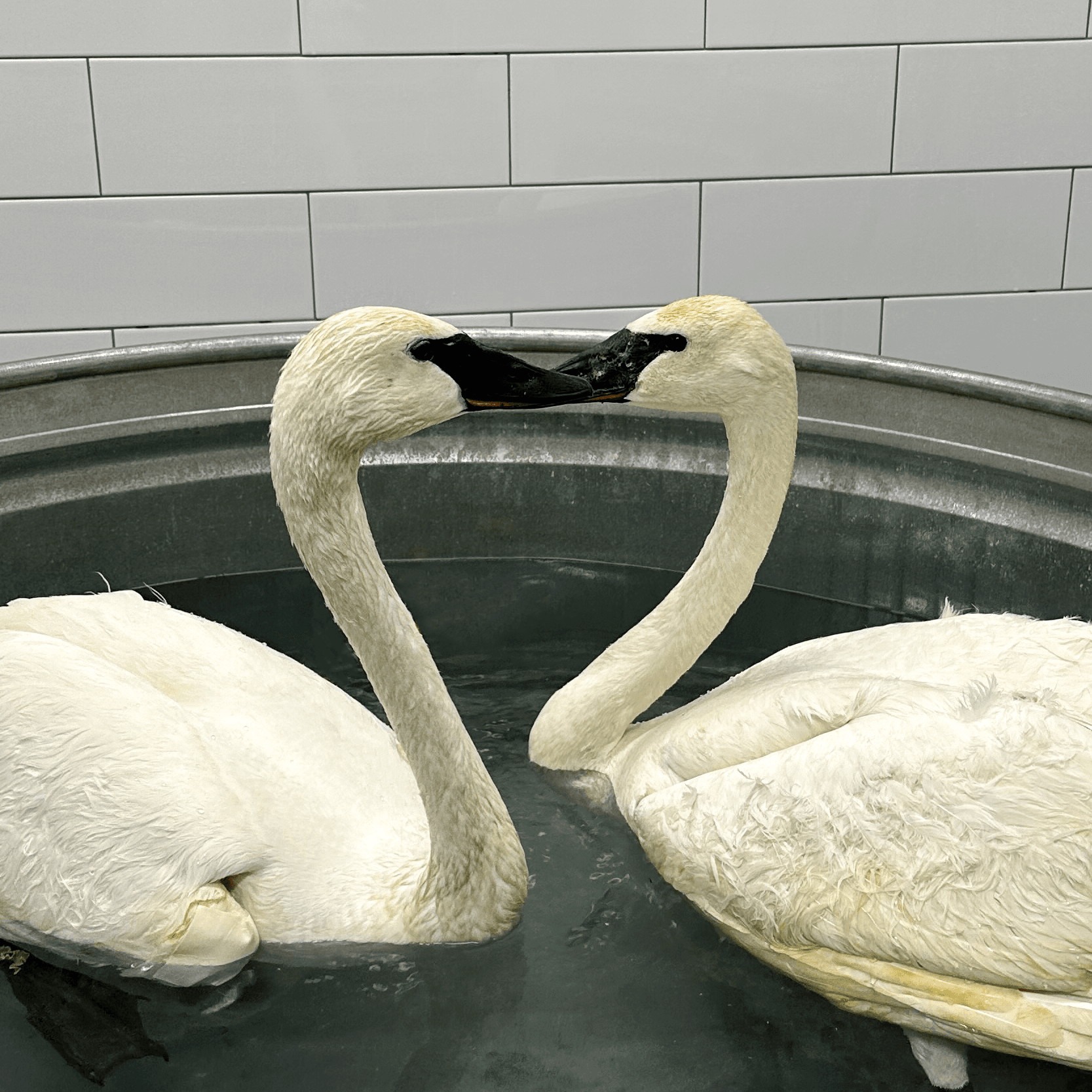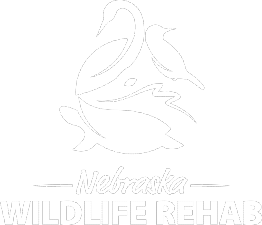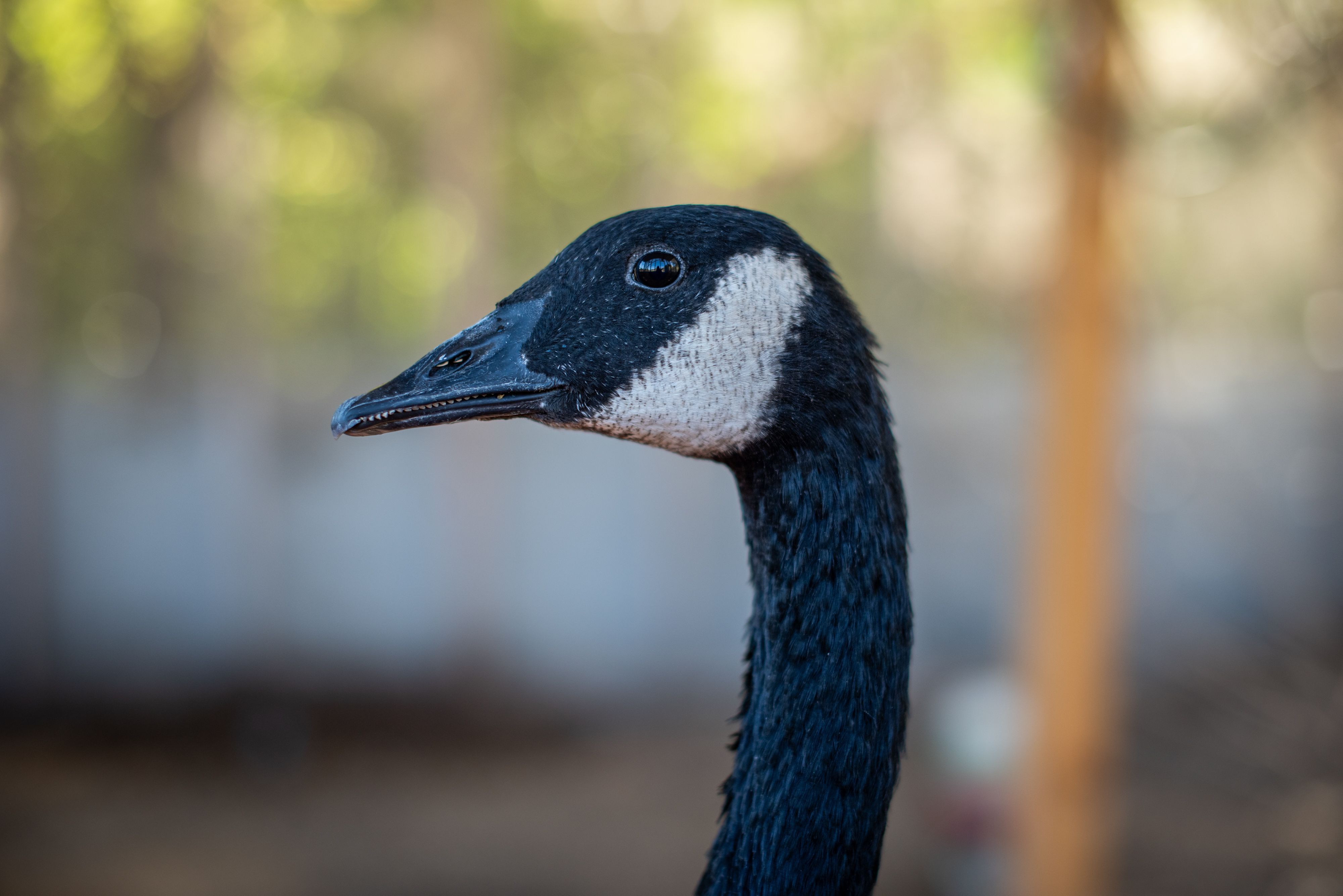
You are looking at the two lone survivors of a flock of thirty trumpeter swans trapped on a frozen lake in Iowa. They were rescued along with several other swans by our friends at Iowa Bird Rehabilitation (IBR) and brought to Nebraska Wildlife Rehab (NWR) for emergency medical treatment at our Hubbard Family Wildlife Hospital. Examinations revealed they were suffering from lead poisoning, a condition where ingestion of lead pellets or particles can result in weakness, incoordination, drooped wings, anorexia, reduced activity and ultimately organ failure – explaining why they were unable to fly from the lake.
Once they arrived, our team immediately went to work performing physical exams, drawing blood for critical lab work, and stabilizing the swans. Ultimately, we performed gastric lavage on each one, a procedure that involves placing the swan under sedation and using water to flush out the contents of their GI tract. Making sure that all of the lead was removed from their bodies ensured that chelation therapy (administering medications to remove the heavy metal from their bodies) was effective. After several days in our ICU here at NWR, the swans were transferred back to IBR for continued care.
The nature of how waterfowl feed makes them particularly susceptible to lead exposure. Their gizzards have adapted to grind the plant material in their diet, and they often consume small rocks to aid in this process. Consequently, any lead that mingles with their food sources undergoes a similar grinding process, accelerating its absorption into the gastrointestinal tract and bloodstream. Trumpeter swans are the largest native waterfowl in North America, weighing up to 25lbs with a wingspan that can spread to 6 feet in length. And yet, as few as one or two pea-sized pellets can result in death. So where is all this lead coming from and why is it killing waterfowl?
Lead toxicity in waterfowl primarily stems from ingesting lead-based ammunition or fishing tackle. As lead pellets from spent shotgun shells accumulate in bodies of water over time, waterfowl may mistakenly ingest them while foraging. Additionally, discarded lead sinkers and lures can be consumed by diving birds, leading to severe health consequences and wreaking havoc on the blood, tissues and organs.
Although lead-shot was federally banned in 1991 for waterfowl hunting, it continues to persist in the environment, often resting in places like the bottom of lake beds. Water levels are historically very low this year so trumpeter swans, using their nearly 2-foot-long necks, can easily forage around the bottom of the lakebed and stir up whatever metal is resting there. Furthermore, lead-based ammunition and fishing lures continue to be used in non-waterfowl hunting and fishing, which means lead will continue to persist in the environment. For example, when an angler neglects to collect their lines and lure, lead is subsequently introduced to the water system from which they were fishing. So, in addition to legacy lead, contamination that remains in the environment from past practices, there continues to be other factors that contribute to the persistence of lead in these environmental systems.
Addressing the issue of lead toxicity in wild spaces requires a multi-faceted approach. Legislation and regulations aimed at phasing out lead-based ammunition and fishing tackle are crucial steps. As of 2019, California is the only state in the country with a 100% lead ammunition ban to protect all wildlife from lead toxicity. Elsewhere, lead ammunition is only partially banned. Another approach is through education campaigns that can raise awareness among hunters, anglers, and the public about the dangers of lead contamination and the availability of non-toxic alternatives. Encouraging the use of non-toxic alternatives, such as steel-shot for hunting and lead-free sinkers for fishing, is vital in mitigating the impact on wildlife populations and their habitats. Collaboration is key, and active cooperation between conservation organizations, government agencies, and the public is essential to implement and enforce effective policies.
Each spring and fall, Nebraska becomes a vital crossroads for avian travelers on their remarkable journeys, with the Platte River serving as a major migratory pathway. Iconic species like sandhill cranes, snow geese, and various songbirds grace the skies and landscapes, creating a symphony of calls and a breathtaking display of wings in flight. Our state serves as a crucial stopover for countless migratory birds, transforming its landscapes into a vibrant spectacle during migration seasons. We must do whatever we can to safeguard this legacy.
YOU CAN HELP SUPPORT OUR WORK WITH WILDLIFE
Your support will help provide expert care for injured, ill and orphaned animals that come through our doors at the Baldwin Wildlife Center. Donate today and give wildlife a second chance!

